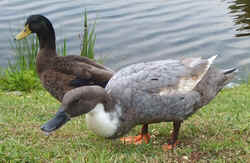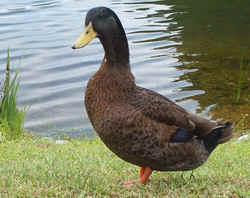 |
 |
Mallard
Scientific Name: Anas platyrhynchos
Family Name: Anatidae
 |
 |
This wide-ranging bird is the most abundant duck in the Mississippi Valley and is increasing in the East; it is common in ponds and fresh-water marshes. Male is told by its green head, white neck band, and rusty breast. Female is mottled brown. Both have a blue speculum, broadly bordered in front and back with white. The Mexican race, A. p. diazi, formerly considered a separate species, used to be a shy, rare, and local resident in the upper Rio Grande Valley of New Mexico. It interbred so extensively with the nominate race that no pure diazi now exist north of Mexico. Very similar to female Mallard. Recognized in flight by its darker tail and, at close range, by unmarked yellow-green bill of male and dark ridge on upper mandible of female. Mallards often flock with Black Ducks. Voice, a loud quack. [Robbins, Chandler S.; Bruun, Bertel and Zim, Herbert S., A Guide to Field Identification Birds of North America, Golden Press, New York, 1983]
Male readily identified by metallic green head and neck, yellow bill, narrow white collar, chestnut breast. Black central tail feathers curl up. Both sexes have white tail, white under-wings, bright blue speculum with both sides border in white. Female's mottled plumage resembles other Anas species; look for orange bill marked with black. Juvenile and eclipse male resemble female but bill is dull olive. Abundant and widespread. Mallards in Mexico, formerly considered a separate species, Mexican Duck, are darker, lack distinctive male plumage; intergrades occur in southwestern U.S. [National Geographic Society, Field Guide to the Birds of North America Second Edition, National Geographic Society, Washington, D.C., 1987]